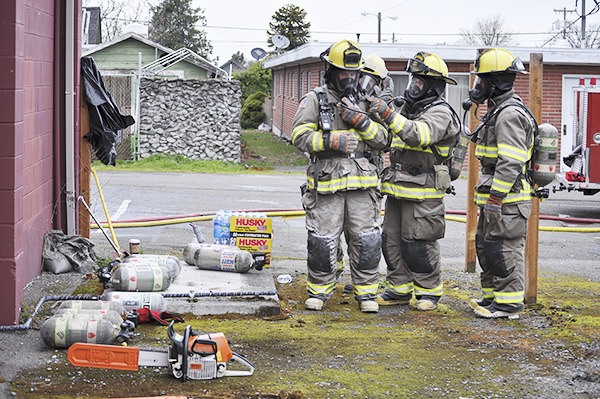Do you have a heart for helping others?
Clallam County Fire District 3 is looking for as many as three dozen volunteers to boost its ranks, particularly at the Diamond Point, Dungeness, Lost Mountain and R Corner stations.
A cadre of dedicated and well-trained volunteers is key to assisting the district’s 18 paid firefighter/paramedics and 16 paid firefighter/EMTs spread across 140 square miles in eastern Clallam County, district Chief Steve Vogel said
“We’re down to 66 volunteers and I’d like to see 100,” Vogel said, admitting it’s not so much the number that’s the goal but long-term commitments he’s seeking.
“We find that we train our volunteers so well they get hired by other agencies,” he said.
Vogel said the district’s need is especially critical at these four all-volunteer stations and that the Washington Survey and Rating Bureau, which provides property underwriting and rating information for the property insurance industry on risk, wants at least six volunteers available at each station to be qualified for operating status.
The closer a structure is to adequate firefighting services, the lower its risk rate and thereby its insurance premiums. Sequim rates a 4, but because there aren’t enough volunteers at Lost Mountain, its rate jumped to a 9-A since last year, Vogel explained.
“Homeowner insurance has doubled or tripled for that area since last year,” he said. Volunteers at these outlying stations would not only be helping their neighbors but themselves as well as homeowners.
“People think they have to be in great shape, but we just want somebody who’s willing to go through the training and be settled in the area. What we’re looking for is stability,” Vogel said.
Unlike paid professionals, volunteers aren’t on call 24/7.
“We ask them to carry a pager and go whenever they’re available to respond,” Vogel said. “We just appreciate them when they can answer a call. It’s an opportunity to give back to the community where you’re living and feeling good about helping your neighbor. If you don’t think you can handle something (i.e. trauma), we’re not asking you to go. You respond to the kinds of calls you feel you can help on.”
Characteristics
A key characteristic district officials look for in volunteers is a sincere desire to serve their community. Being a bit of an “adrenalin hound” doesn’t hurt either. Other requirements include being a non-tobacco user, being beardless (because of breathing apparatus), having a good driving record and a having a clean criminal background.
“We will do a criminal background check on all potential volunteers because we’re going into others’ homes and we don’t want to put anyone in jeopardy,” Vogel said. “Our motto is ‘Serve, Respect, Prevent and Protect’ and we expect all our members to follow that motto.”
There are no specific age requirements other than being at least 18 and Vogel said it would be great to recruit retirees in their 50s and 60s.
Getting started
Those interested in volunteering can fill out an interest card at Station 34 to begin the recruitment process. Both men and women are encouraged to apply because they’re “equally valuable,” Vogel said.
“We first collect a bunch of interest cards and invite those folks for an orientation night with expectations and information about training and the benefits and negatives,” he said. “They make the determination if they want to put in for training; if so, they complete an application and we do a background check, then notify them when there’s a recruiting class. The next one probably will be in late fall.”
Training
Vogel stressed that volunteers need to commit to completing the 200 hours of training over a three-month period, which involves two nights a week and every Saturday, before they consider volunteering. The district pays for volunteer training and instructors come from within its ranks.
Volunteers aren’t required to be CPR-certified, but department members will train them in it once they join the district. Volunteers are reimbursed for gas expenses and receive a small stipend for calls and drills they attend.
“They learn to handle hoses and ladders, about fire suppression techniques, ventilation, hazardous materials, basic first aid, overhaul (post-fire cleanup), salvage, basic arson awareness, water supply and pumper operations,” Vogel said. “Once a volunteer, we expect them to drill at least one Monday a month and to work to the level of their training (on scenes). This year we’re looking at training volunteers to be exterior firefighters only, which requires a lower level of training, for prevention and support.”
Once volunteers successfully complete the training, they’re assigned to the station nearest their residence and are issued pagers which tone them out to their particular station with the address and type of incident. Vogel said district policy is to have volunteers report to their station for the fire trucks or tankers needed before rolling on the scene.
“On a big fire, it takes a minimum of 16 firefighters to make the operation run effectively — everybody has a job and we want to be able to assign these jobs when we get to the scene,” Vogel said.
“Volunteers can set up rehab stations for firefighters, help with radio communications, resupply air packs, watch the exterior, set up fans and lights, perform traffic control. There are lots and lots of jobs.”
Get involved
Volunteer interest cards are available at Station 34, 323 N. Fifth Ave., Sequim, during regular business hours from 8 a.m.-5 p.m. Monday-Friday.


